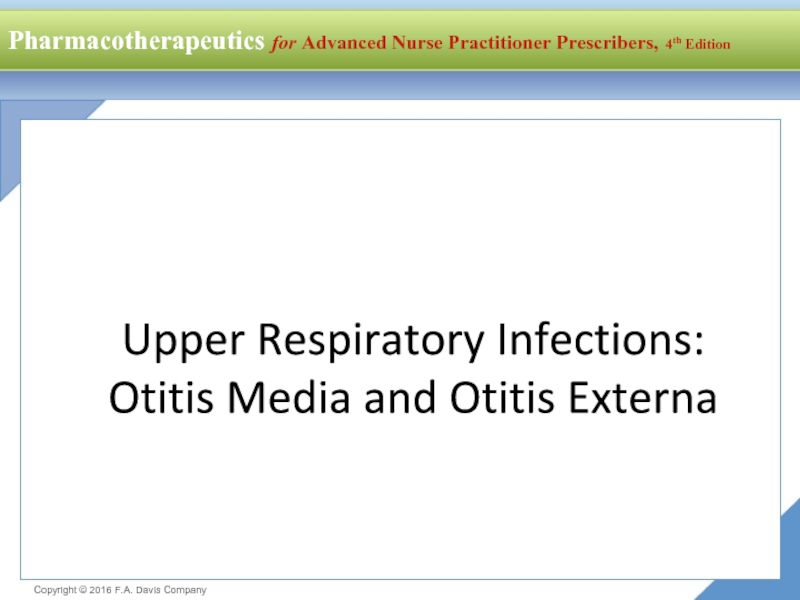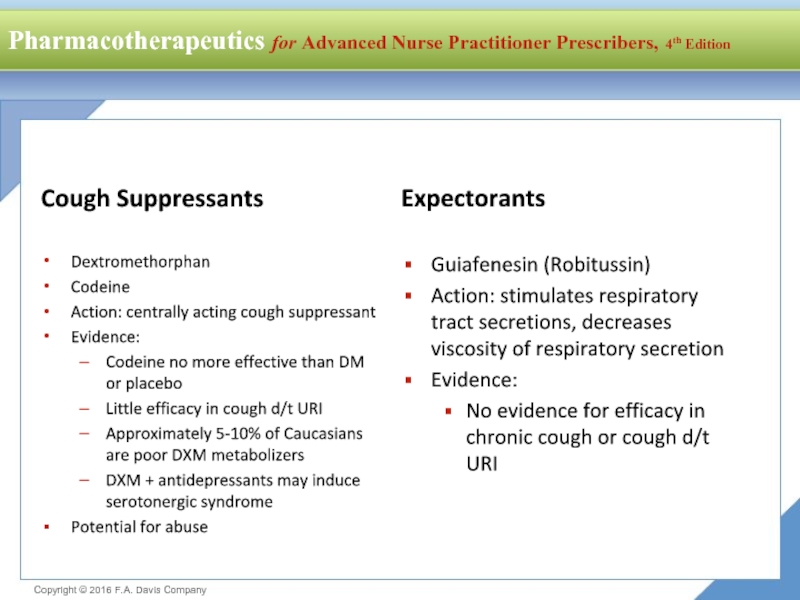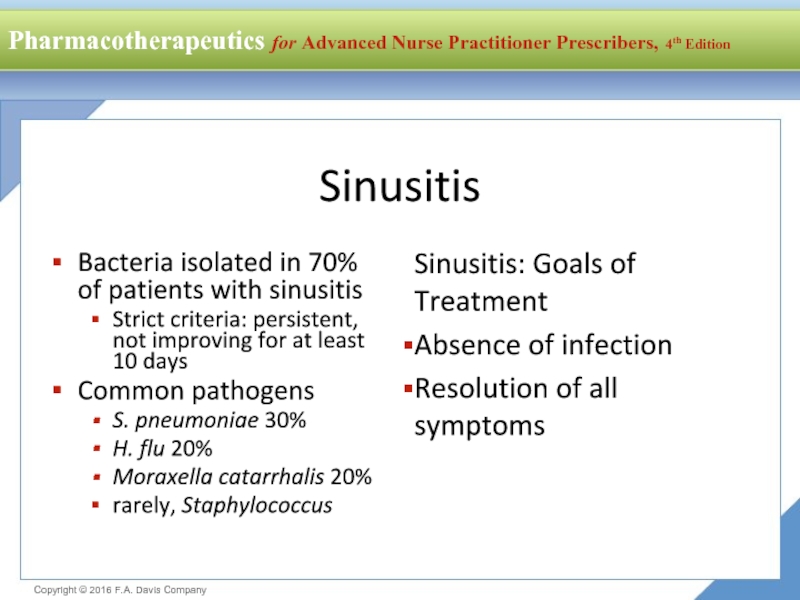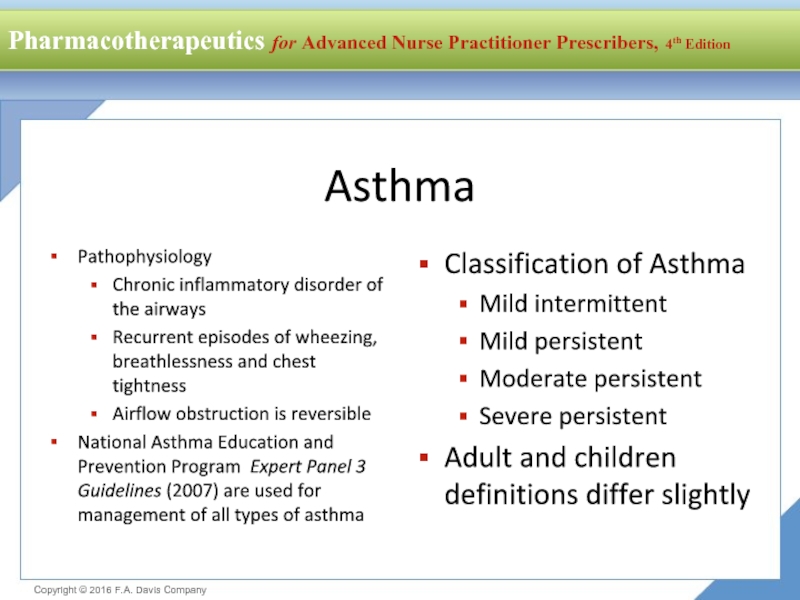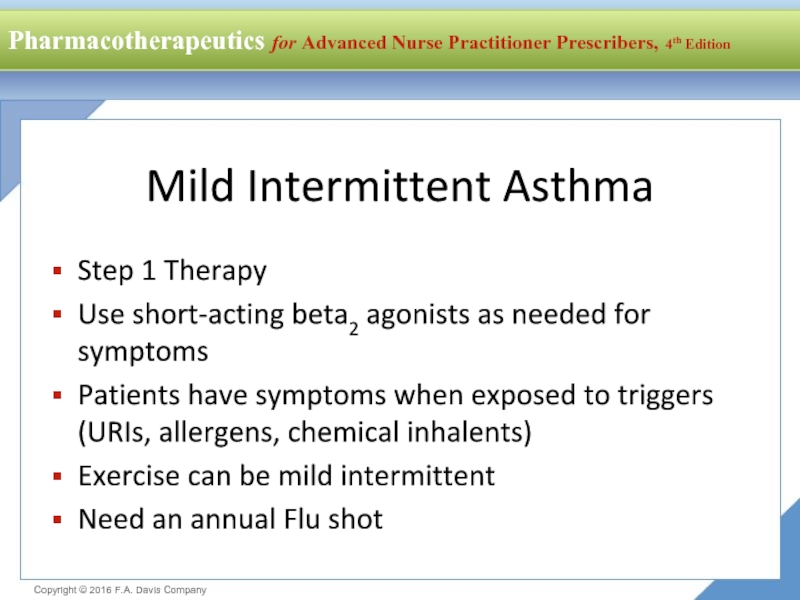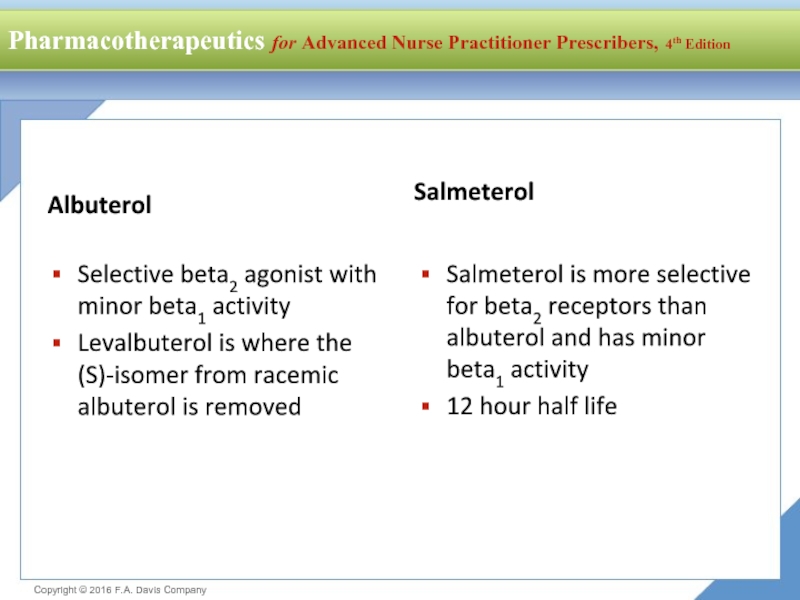- Главная
- Разное
- Дизайн
- Бизнес и предпринимательство
- Аналитика
- Образование
- Развлечения
- Красота и здоровье
- Финансы
- Государство
- Путешествия
- Спорт
- Недвижимость
- Армия
- Графика
- Культурология
- Еда и кулинария
- Лингвистика
- Английский язык
- Астрономия
- Алгебра
- Биология
- География
- Детские презентации
- Информатика
- История
- Литература
- Маркетинг
- Математика
- Медицина
- Менеджмент
- Музыка
- МХК
- Немецкий язык
- ОБЖ
- Обществознание
- Окружающий мир
- Педагогика
- Русский язык
- Технология
- Физика
- Философия
- Химия
- Шаблоны, картинки для презентаций
- Экология
- Экономика
- Юриспруденция
Respiratory agents презентация
Содержание
- 1. Respiratory agents
- 2. Upper Respiratory Infections: Otitis Media and Otitis Externa
- 3. Viral Upper Respiratory Infections Rhinovirus most common
- 4. URI Symptoms Nasal congestion Rhinorrhea Malaise Scratchy
- 5. URI Treatment Symptomatic care Fluids, antipyretics Nasal
- 6. Decongestants Systemic Sympathomimetics Pseudoephedrine Phenylephrine Topical decongestants Phenylephrine (Neosynephrine) Oxymetazoline (Afrin)
- 7. Oral Decongestants Action: vasoconstriction of capillary vessels,
- 8. Cough Suppressants Dextromethorphan Codeine Action: centrally acting
- 9. Sinusitis Bacteria isolated in 70% of patients
- 10. Antibiotic choices for Sinusitis Amoxicillin first line
- 11. Acute Otitis Media (AOM) Caused by eustachian
- 12. AAP/AAFP Guidelines for AOM in Children
- 13. Criteria for Initial Antibacterial-Agent Treatment or Observation in Children With AOM (AAP, 2013)
- 14. AOM Antibiotic Choices Amoxicillin is first choice
- 15. AOM Initial observation for 48 hrs Low
- 16. AOM treatment failure at 48-72 hrs If
- 17. AOM Patient Education Proper use of
- 18. Asthma and COPD
- 19. Asthma Pathophysiology Chronic inflammatory disorder of the
- 20. Asthma Goals of Therapy Reduce Impairment Prevent
- 21. Mild Intermittent Asthma Step 1 Therapy
- 22. Beta2 Receptor Agonists Short-acting beta agonists
- 23. Albuterol Selective beta2 agonist with minor beta1
- 24. Beta Agonists Clinical Use Exercise induced bronchospasm
- 25. Beta2 Agonists Precautions and Contraindications Cardiac
- 26. Beta Agonists: Drug Interactions Digitalis glycosides:
- 27. Monitoring Once control is achieved, the
- 28. Managing Exacerbations Treat with oral steroids to
- 29. Mild Persistent Asthma Step 2 Therapy
- 30. Moderate Persistent Asthma Step 3 Therapy
- 31. Severe Persistent Asthma Step 4 Therapy
Слайд 3Viral Upper Respiratory Infections
Rhinovirus most common virus
Adenovirus
RSV
Coronavirus
Enteroviruses
Children get 6 to
More if in daycare
Adults average 2.5 URIs per year
Last 7-9 days
Significant runny nose and cough on days 1 to 4 predictive for viral origin
Слайд 4URI Symptoms
Nasal congestion
Rhinorrhea
Malaise
Scratchy or sore throat
The nasal discharge typically starts out
Generalized muscle aches
Adults usually don’t have a fever
Children may have low-grade fever
Слайд 5URI Treatment
Symptomatic care
Fluids, antipyretics
Nasal bulb suctioning in infants
Decongestants in older children
No antibiotics
No difference in clinical outcomes
Слайд 6Decongestants
Systemic Sympathomimetics
Pseudoephedrine
Phenylephrine
Topical decongestants
Phenylephrine (Neosynephrine)
Oxymetazoline (Afrin)
Слайд 7Oral Decongestants
Action: vasoconstriction of capillary vessels, theoretically decreasing congestion
ADRs
Tachycardia
Hypertension
Anxiety/restlessness/irritability
There is
Use may be hazardous
In 2004-05 1,519 children aged <2 years were treated in U.S. emergency departments for adverse events from cough/cold medications
Deaths in infants and young children
Слайд 8Cough Suppressants
Dextromethorphan
Codeine
Action: centrally acting cough suppressant
Evidence:
Codeine no more effective than DM
Little efficacy in cough d/t URI
Approximately 5-10% of Caucasians are poor DXM metabolizers
DXM + antidepressants may induce serotonergic syndrome
Potential for abuse
Expectorants
Guiafenesin (Robitussin)
Action: stimulates respiratory tract secretions, decreases viscosity of respiratory secretion
Evidence:
No evidence for efficacy in chronic cough or cough d/t URI
Слайд 9Sinusitis
Bacteria isolated in 70% of patients with sinusitis
Strict criteria: persistent, not
Common pathogens
S. pneumoniae 30%
H. flu 20%
Moraxella catarrhalis 20%
rarely, Staphylococcus
Sinusitis: Goals of Treatment
Absence of infection
Resolution of all symptoms
Слайд 10Antibiotic choices for Sinusitis
Amoxicillin first line
Dose at 80-90 mg/kg/day in high-risk
45 mg/kg/day in low risk children
Adults 500 mg TID
Or high-dose Augmentin
For PCN allergic patients
Children: cefdinir, cefuroxime, or cefpodoxime
Adults: doxycycline or respiratory fluoroquinolone (levofloxacin)
Sinusitis: Worsening after 72 hrs
Consider bacterial resistance
Switch to Augmentin if amoxicillin was first choice
If started on Augmentin:
Adults: consider respiratory fluoroquinolone (levofloxacin)
Children: cefdinir, cefuroxime, cefpodoxime
Слайд 11Acute Otitis Media (AOM)
Caused by eustachian tube dysfunction
Negative pressure causes
Pathogens
S. pneumoniae
Nontypeable H. influenzae
M. catarrhalis
Microbiology is changing due to PCV vaccine
H. flu increasing, S. pneumoniae decreasing
Respiratory viruses account for 40 to 75% of AOM cases in children
AOM Diagnosis
Diagnosis of AOM requires
Moderate to severe bulging of TM or new onset of otorrhea
Mild bulging of TM and < 48 hrs of ear pain or intense erythema of TM
Bullous myringitis
thin-walled bulla
Слайд 12AAP/AAFP Guidelines for AOM in Children
Initial observation without antibiotics for
If treating AOM with antibiotics, amoxicillin dosed at 80 to 90 mg /kg/day is first choice
Слайд 13Criteria for Initial Antibacterial-Agent Treatment or Observation in Children With AOM
Слайд 14AOM Antibiotic Choices
Amoxicillin is first choice
Or amoxicillin/clavulanate 90mg/kg/day of amoxicillin
AOM antibiotics
cefdinir (14 mg/kg per day in 1 or 2 doses)
cefpodoxime (10 mg/kg per day, once daily)
cefuroxime (30 mg/kg per day in 2 divided doses)
Ceftriaxone 50 mg IM 1 day or x 3 days
Слайд 15AOM Initial observation for 48 hrs
Low risk patient
> age 2 years
Mild otalgia
Temp < 39 degrees
Adequate pain management is essential
“Safety net” prescription
WASP “Wait and See Prescription”
Слайд 16AOM treatment failure at 48-72 hrs
If initially treated with amoxicillin or
Augmentin
Ceftriaxone IM/IV x 3 days
PCN allergic:
Clindamycin plus third generation cephalosporin
Слайд 17AOM Patient Education
Proper use of the prescribed antibiotic
The predicted
Follow up in 2 to 3 days if no improvement
Pain control
Слайд 19Asthma
Pathophysiology
Chronic inflammatory disorder of the airways
Recurrent episodes of wheezing, breathlessness and
Airflow obstruction is reversible
National Asthma Education and Prevention Program Expert Panel 3 Guidelines (2007) are used for management of all types of asthma
Classification of Asthma
Mild intermittent
Mild persistent
Moderate persistent
Severe persistent
Adult and children definitions differ slightly
Слайд 20Asthma
Goals of Therapy
Reduce Impairment
Prevent chronic symptoms
Reduce use of inhaled short-acting
Maintain normal or near normal pulmonary function
Maintain normal activity levels
Meet patient/family expectations of asthma care
Reduce Risk
Prevent recurrent exacerbations and minimize ED visits and hospitalizations
Prevent loss of lung function
Provide optimal therapy with minimal ADRs
Слайд 21Mild Intermittent Asthma
Step 1 Therapy
Use short-acting beta2 agonists as
Patients have symptoms when exposed to triggers (URIs, allergens, chemical inhalents)
Exercise can be mild intermittent
Need an annual Flu shot
Слайд 22Beta2 Receptor Agonists
Short-acting beta agonists
Albuterol (ProAir, Ventolin, Proventil)
metaproterenol (Alupent)
terbutaline (Brethine,
bitolterol (Tornalate)
pirbuterol (Maxair )
levalbuterol (Xopenex)
Long-acting beta agonists
salmeterol (Serevent)
formoterol (Foradil)
Indacaterol (Arcapta Neohaler)
arformoterol (Brovana)
Слайд 23Albuterol
Selective beta2 agonist with minor beta1 activity
Levalbuterol is where the (S)-isomer
Salmeterol
Salmeterol is more selective for beta2 receptors than albuterol and has minor beta1 activity
12 hour half life
Слайд 24Beta Agonists Clinical Use
Exercise induced bronchospasm
Albuterol 2 puffs 15 min before
Salmeterol 2 puffs 30 to 60 min before exercise
Do not use if already on daily dose of salmeterol
Leukotriene modifiers taken daily may decrease EIB symptoms in 50% of patients, but pt will still need to use albuterol before exercise
Слайд 25Beta2 Agonists
Precautions and Contraindications
Cardiac arrhythmias
Diabetics: potential drug-induced hyperglycemia
Long-acting beta agonists:
Black
2-fold increase in catastrophic events (asthma related intubations and death)
Terbutaline Pregnancy Category B (others Cat C)
Children:
Albuterol safe for all age children
Salmeterol should not be used in children < age 4 yrs and never singly
Слайд 26Beta Agonists: Drug Interactions
Digitalis glycosides: increased risk of dysrhythmia
Beta adrenergic
Including beta blocker eye drops
TCAs and MAOIs potentiate effects of beta agonist on vascular system
Слайд 27Monitoring
Once control is achieved, the patient is seen every 1
The Expert Panel III guidelines recommend the dose of inhaled corticosteroids be reduced about 25% to 50% every 2 to 3 months to lowest possible dose to maintain control
Слайд 28Managing Exacerbations
Treat with oral steroids to regain control
Use a short
Adults: 40 to 60 mg/day x 5 to 10 days
Children: 1 to 2 mg/kg daily (max 60 mg/day) x 3 to 10 days
If not effective then step up in therapy
Слайд 29Mild Persistent Asthma
Step 2 Therapy
Treat with one long-term control
Low dose inhaled corticosteriods are the mainstay for all age patients
Cromolyn or a leukotriene modifier are alternative
See dosage charge for low dose schedule of each inhaled corticosteroid
Use beta agonists as needed, if using more than > 2 days per week then step up in therapy
Слайд 30Moderate Persistent Asthma
Step 3 Therapy
Treat with medium-dose inhaled corticosteroids
Or
Alternative: medium dose inhaled steroid plus leukotriene receptor modifier
May use short acting beta agonists
Exacerbations may require oral corticosteroids
Слайд 31Severe Persistent Asthma
Step 4 Therapy
Medium-dose inhaled inhaled corticosteroids plus
Or medium-dose inhaled corticosteroid and a leukotriene modifier or theophylline
Step 5 Therapy
High-dose inhaled corticosteroids plus long-acting beta agonists
Step 6 Therapy
High dose inhaled corticosteroids plus long-acting beta agonists and oral corticosteroids
Severe persistent asthma requires consultation with asthma specialist

